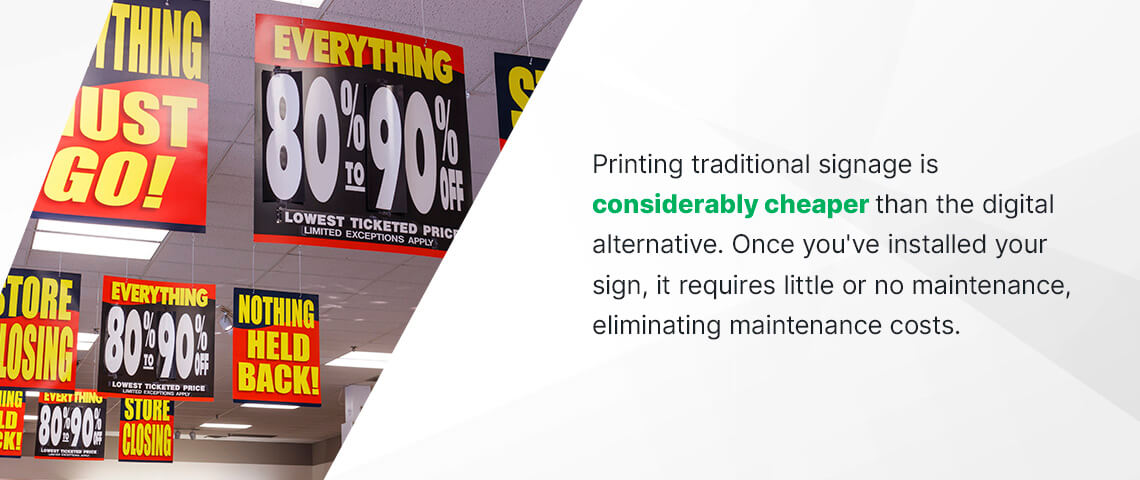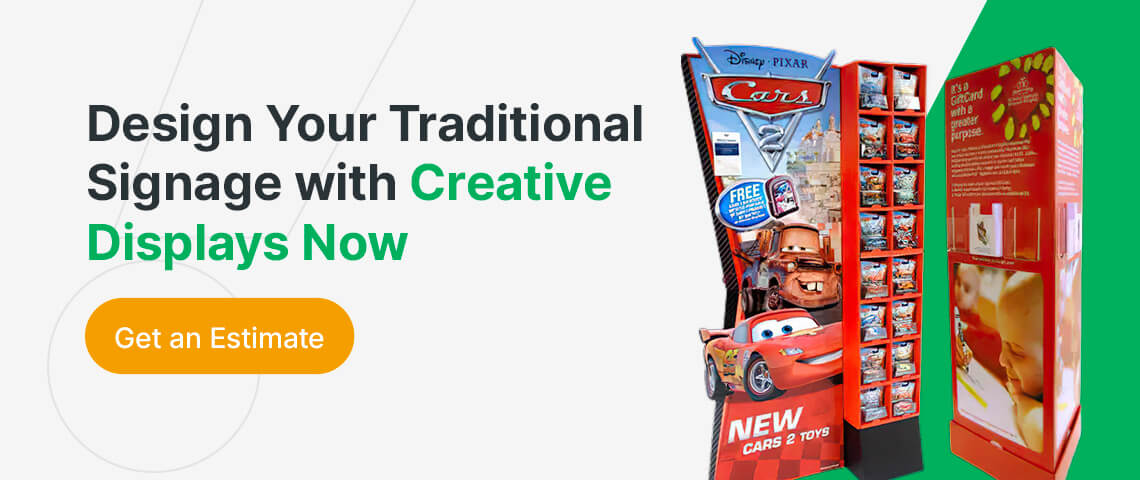The world of visual marketing is always changing. Still, one thing remains constant — signage drives foot traffic, encourages impulse purchases and increases brand awareness. The fast-paced world of digital signage has much to offer in a retail environment. However, there is still a significant need for traditional in-store signage. In some cases, traditional signage may be more important than digital, and it’s vital that your business knows which is which.
When weighing the advantages and drawbacks of digital signage vs. traditional signage, the pros of traditional signage are worth noting when making business decisions.
What Is Traditional Signage?
Traditional or static signage is a large print format advertising tool used to display brand messages and advertisements in several settings. Cardboard retail displays are a typical example of traditional signage. In retail, it’s common to see three types of traditional signage, including the following:
- Hanging ceiling signs: Enticing language, attractive images, and aesthetically pleasing color combinations encourage customers in-store to act on the message and purchase.
- Floor signs: Sturdy structures that stand independently on the floor and often highlight specific deals and promotions.
- Shelf signs: A combination of promotional language and products that customers can add to their shopping carts. These signs are strategically placed in high-traffic areas for maximum impact.
Aside from these three examples, there are many applications for traditional signage as part of visual merchandising displays for many industries, including electronics, pet supplies, beverages and hardware.
The Pros and Cons of Traditional Signage
Traditional and digital signage perform the same essential function, but each has pros and cons. Some of the advantages of traditional signage include the following:
- Reliability: Traditional signage doesn’t require electricity and will continue advertising your brand during a power outage or bad weather. There are no moving parts — once you’ve installed it correctly, your message is visible until you take it down.
- Versatility: You can install traditional signage anywhere. There are no limitations to where you can position your brand.
- Cost-effectiveness: Printing traditional signage is considerably cheaper than the digital alternative. Once you’ve installed your sign, it requires little or no maintenance, eliminating maintenance costs.
- Eco-friendly: Except for plastic signs, traditional signage materials are recyclable. As many customers want to buy products that align with their values, it’s a perfect option for sustainability-focused businesses.
No method is foolproof, however, and traditional signage has some drawbacks to consider, including the following:
- Manual graphics changes: If you need to change the graphics on one of your signs, you need someone on-site to help you, and you may even have to hire an installer.
- Limited interactivity: Traditional signage is static, so there is little room for customers to interact with your displays. However, you can use clever designs and graphics to give a 3D effect.
What Is Digital Signage?
Digital signage, or electronic signage, refers to various electronic display technologies like video light emitting diode (LED) walls, projectors and liquid crystal display (LCD) monitors and interactive touch screens. You can find digital signage in various settings, including malls, other public spaces, sports stadiums, corporate spaces, restaurants and retail stores.
Many businesses use digital retail signage to personalize the customer experience. Customers can interact with the displays, choose products that suit their needs and get relevant information. Digital signage is only sometimes interactive but is quick to change to convey messages suited to the time of day, like announcing lunchtime specials outside a restaurant.
The Pros and Cons of Digital Signage
Depending on the application, digital signage has several advantages, including the following:
- Flexibility: If you want to change a graphic for a specific time of day or to highlight a particular product, you can do so instantly with digital signage.
- Interactivity: Digital signage offer many options. You can add video, audio and interactive touch capabilities, creating a personalized customer experience.
- Data analytics: Interactive digital signage can provide valuable data on customer engagement so you can refine your marketing strategy.
Despite the benefits of digital signage, there are some limitations to consider, including the following:
- Power requirements: Digital signage relies on power to operate, which means your location is limited to spaces that offer a reliable power source. If there is a power outage, customers will have no access to your brand and power surges can damage your equipment.
- Reliability: You rely on many moving parts for effective digital signage, from an internet connection and media players to screens and content management system (CMS) software. If any of these components break down, your message fails to reach your customers.
- Cost: An effective digital signage setup requires a higher upfront cost, and you must factor in the recurring repair and maintenance costs necessary to keep the system up and running.
Which Type of Signage is Best for Your Business?
Traditional and digital signage have drawbacks and limitations, but each has applications it suits. Choosing the right option for your business depends on several factors. Consider the following when making your decision:
Your Power Supply
As digital signage relies entirely on electricity, consider the retail stores where your product is available. Do they have a reliable power supply and backup in case of blackouts? If you want your signage to be visible to potential customers regardless, traditional signage is the safer option.
Your Location
Consider where you would like to display your signage. Indoor signage is relatively safe, but outdoor displays must withstand the elements. Whether your signage is temporary also makes a difference. They should be easy to move and install if you need portable options.
The Cost
Your budget also plays a significant role in your type of signage. Digital signage has higher upfront and maintenance costs. Traditional signage is a once-off investment. You design and purchase the signs you need and pay for the installation. When the signage has fulfilled its purpose, you can recycle it and create something new.
Your Brand
The signage best suited to your brand may depend on your values and the products you offer. Many consumers factor sustainability into their purchase choices — green purchase and marketing are vital considerations. If being eco-friendly is essential to your brand values and reputation, recyclable traditional signage is more likely to align with your values.
Design Your Traditional Signage with Creative Displays Now
Despite the benefits of digital signage, traditional options have much to offer across industries. Designing and creating well-conceived signage can elevate your brand and engender trust amongst new and existing customers. With over 60 years in the display and packaging business, Creative Displays Now thoroughly understands display specifications and requirements for major retailers. We take care of everything, from design to distribution, providing fast, quality signage outcomes that meet your business needs.
We understand how important it is to market your products correctly, and we can help your business benefit more people. Feel free to request an estimate today, and let Creative Displays Now help you transform your brand!





